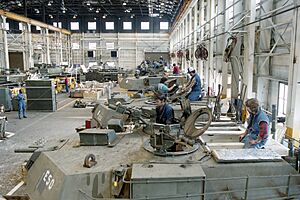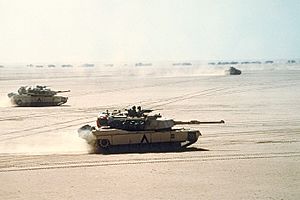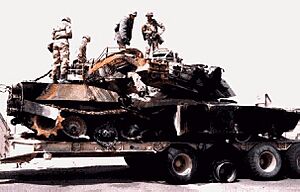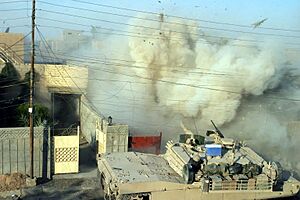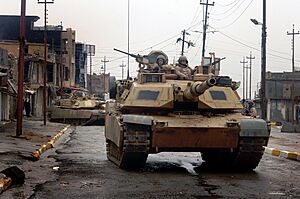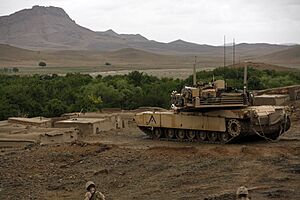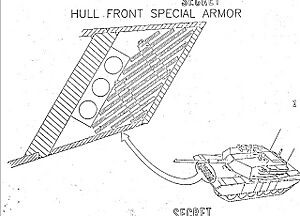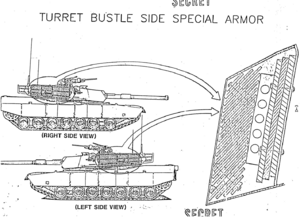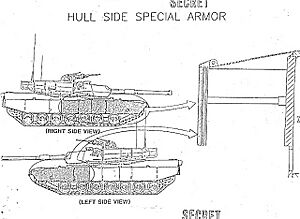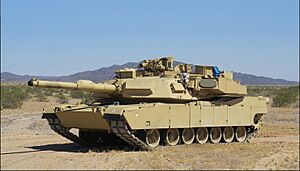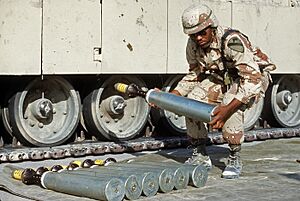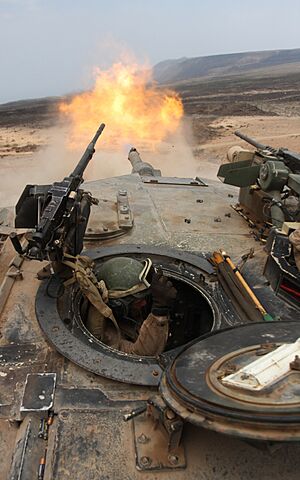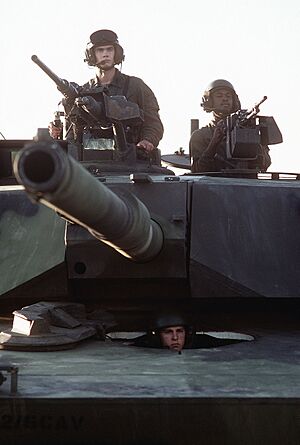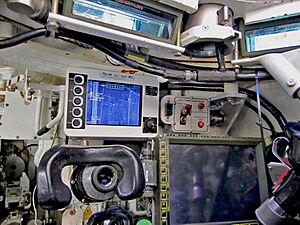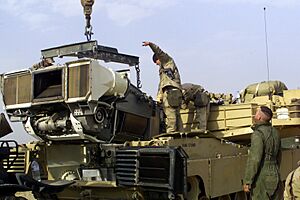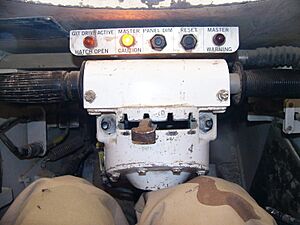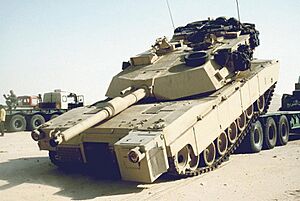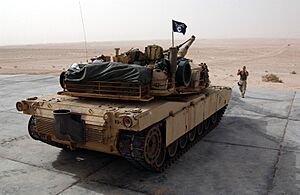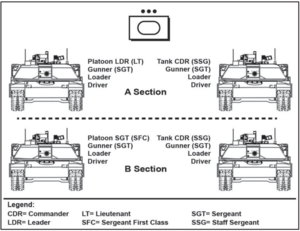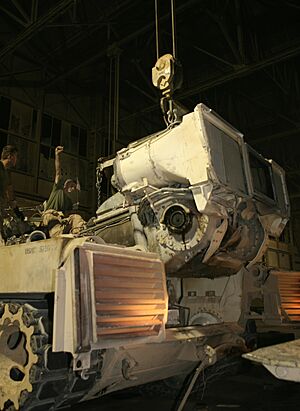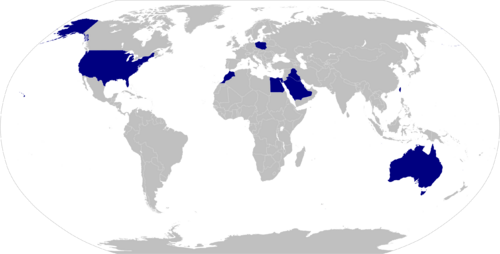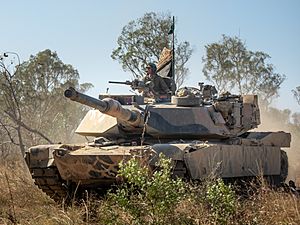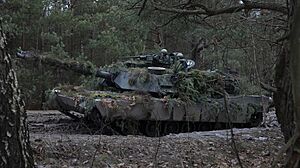M1 Abrams facts for kids
Quick facts for kids M1 Abrams |
|
|---|---|
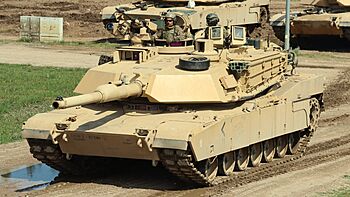
M1A2 SEPv3
|
|
| Type | Main battle tank |
| Place of origin | United States |
| Service history | |
| In service | 1980–present |
| Used by | See Operators below |
| Wars |
|
| Production history | |
| Designer | Chrysler Defense (now General Dynamics Land Systems) |
| Designed | 1972–1976 |
| Manufacturer | Lima Army Tank Plant (since 1980) Detroit Arsenal Tank Plant (1978, 1982–1991) Egyptian Defense Company Tank Plant |
| Unit cost | M1A1: $4.3 million (domestic cost, FY1989) (~$10.66 million, FY2023) M1A2 SEPv3: $24 million (export cost, FY2022) |
| Produced | 1979–present |
| No. built | approx. 10,300 as of 2017 |
| Variants | See variants |
| Specifications | |
| Mass | M1: 60 short tons (54 t) M1A1: 63 short tons (57 t) M1A1 SA: 67.6 short tons (61.3 t) M1A2 SEPv2: 71.2 short tons (64.6 t) M1A2 SEPv3: 73.6 short tons (66.8 t) |
| Length | Gun forward: 32.04 ft (9.77 m) Hull length: 26.02 ft (7.93 m) |
| Width | 12 ft (3.66 m) |
| Height | 8 ft (2.44 m) |
| Crew | 4 (commander, gunner, loader, driver) |
|
|
|
| Elevation | +20° / −10° |
| Traverse | 9 seconds/360 degrees |
|
|
|
| Armor | Composite armor |
|
Main
armament |
M1: 105 mm L/52 M68A1 rifled gun (55 rounds) M1A1+M1A2: 120 mm L/44 M256 smoothbore gun (40 rounds) |
|
Secondary
armament |
1 × 0.50 caliber (12.7 mm) M2HB heavy machine gun with 900 rounds 2 × 7.62 mm (.308 in) M240 machine guns with 10,400 rounds (1 pintle-mounted, 1 coaxial) |
| Engine | Honeywell AGT1500 multi-fuel turbine engine 1,500 shp (1,120 kW) |
| Power/weight | From 26.9 hp/t (20.05 kW/t) to 23.8 hp/t (17.74 kW/t) |
| Transmission | Allison DDA X-1100-3B |
| Suspension | High-hardness-steel torsion bars with rotary shock absorbers |
| Ground clearance | M1, M1A1: 0.48 m (1.6 ft; 19 in) M1A2: 0.43 m (1 ft 5 in) |
| Fuel capacity | 504.4 US gallons (1,909 L) |
|
Operational
range |
M1A2, road: 265 mi (426 km) Cross country: 93–124 mi (150–200 km) |
| Maximum speed | M1A1, road: 45 mph (72 km/h) (governed); M1A2, road: 42 mph (67 km/h) (governed); Off-road: 25 mph (40 km/h) |
The M1 Abrams is a powerful American main battle tank. It was designed by Chrysler Defense and is named after General Creighton Abrams. This tank is one of the heaviest in service, weighing almost 73.6 tons.
The M1 Abrams brought many new technologies to the U.S. military. These include a special gas turbine engine that can use different types of fuel. It also has advanced composite armor, a computer system to help aim its gun, and a safe way to store ammunition. The crew is also protected from chemical, biological, and nuclear (CBRN) threats.
Early M1 tanks used a 105 mm gun. Later versions, like the M1A1 and M1A2, use a more powerful 120 mm gun. The M1 Abrams was first used in combat during the Gulf War in 1991. It has since been used in many other conflicts, including the Iraq War and the Russian invasion of Ukraine.
The U.S. Army still uses the M1 Abrams as its main battle tank. It is also used by the armies of Egypt, Kuwait, Saudi Arabia, Australia, Poland, Iraq, and Ukraine.
Contents
- History of the Abrams Tank
- How the Abrams Tank Was Developed
- Starting a New Tank Design
- Testing the Prototypes
- Chrysler's Design Is Chosen
- Production Begins
- The 120 mm Gun M1A1
- The Gulf War (1991)
- Upgrades and Improvements
- The Iraq War (2003-2011)
- Tank Urban Survival Kit (TUSK)
- Iraqi Army Service
- War in Afghanistan
- Yemeni Civil War (2015)
- Russo-Ukrainian War (2022-Present)
- Future Plans for the Abrams
- Design Features of the Abrams
- Armament of the Abrams
- Mobility and Movement
- Tank Platoon Operations
- Abrams Tank Versions and Upgrades
- Abrams Specifications
- Who Uses the Abrams Tank?
- See also
History of the Abrams Tank
How the Abrams Tank Was Developed
In 1963, the U.S. Army and West Germany worked together to design a new main battle tank. This project was called the MBT-70. It was meant to replace older tanks like the M60 tank. The MBT-70 was very advanced, with a special gun that could fire missiles. It also had a unique suspension system that allowed the tank to be raised or lowered.
However, the project faced many problems. The U.S. and German teams had different ideas about the design. The tank also became too heavy and too expensive. Because of these issues, the MBT-70 project was canceled in 1970. The U.S. Army then decided to start fresh with a new tank design.
Starting a New Tank Design
In 1972, the U.S. Army began the XM815 project, which was later renamed XM1. The goal was to create a tank that could withstand hits from Soviet guns. It would use a 105 mm gun, which was a licensed version of a British gun.
A big breakthrough came when the Army learned about a new type of armor called "Burlington" armor (also known as Chobham armor) from the British Army. This armor was very good at stopping special types of explosives. To use this new armor effectively, the tank needed to be much thicker. General Creighton Abrams set the tank's weight limit at 53 tons.
The U.S. Army wanted to avoid the cost problems of the MBT-70. They set a strict budget for the new tank. In 1973, Chrysler Defense and General Motors submitted their designs. Chrysler chose a powerful gas turbine engine, while GM used a diesel engine.
Testing the Prototypes
In 1976, Chrysler and GM delivered their prototype tanks for testing. The tests showed that GM's design was generally better. It had stronger armor and better systems for aiming and stabilizing the gun.
However, both designs had problems with their engines. Chrysler's gas turbine engine used a lot more fuel than expected. GM's diesel engine also had issues.
Despite GM's design being better, the U.S. Secretary of Defense, Donald Rumsfeld, insisted that the new tank should use a turbine engine. This decision favored Chrysler, as they were the only company with a turbine engine design.
Chrysler's Design Is Chosen
Chrysler worked to improve its design and lower costs. They replaced expensive parts with cheaper ones. In November 1976, the Defense Department gave the contract to Chrysler.
Eleven pre-production XM1 tanks were made between 1978 and 1979. During testing, some minor problems were found, like mud getting stuck under the hull and engine issues. However, these problems were easily fixed. Critics at the time raised concerns about the tank's cost and fuel use, but the program had strong support.
Production Begins
Production of the M1 Abrams began in 1979. The first tanks entered service with the U.S. Army in 1980. Over 3,200 M1 Abrams tanks were produced between 1979 and 1985. The M1 used the 105 mm gun and the new Chobham armor. An improved version, the IPM1, was made briefly in 1984 with better armor.
The 120 mm Gun M1A1
The U.S. Army decided to upgrade the Abrams with a more powerful 120 mm smoothbore gun. This gun was designed in Germany and made under license in the U.S. About 5,000 M1A1 Abrams tanks were produced from 1986 to 1992. These tanks had the new 120 mm gun, improved armor that included depleted uranium, and a CBRN protection system.
The M1A1 Abrams tanks were used in many military exercises during the Cold War. These exercises prepared U.S. and NATO forces to counter potential Soviet threats. Before the Gulf War, the tanks received further upgrades to their firepower and protection.
The Gulf War (1991)
The M1 Abrams was first used in combat during the Gulf War in 1991. The U.S. Army sent nearly 2,000 M1A1 tanks to Saudi Arabia. The M1A1 was much better than the older Soviet-designed tanks used by Iraq, such as the T-72.
The M1A1 could hit enemy tanks from over 2,500 meters away. Iraqi tanks had a shorter range, giving the Abrams a big advantage. Very few M1 tanks were hit by enemy fire, and none were destroyed directly by enemy fire. Most of the Abrams tanks that were damaged or destroyed were due to friendly fire or were intentionally destroyed by U.S. forces to prevent them from being captured.
Upgrades and Improvements
The M1A2 was a major upgrade to the M1A1. It included a special thermal viewer for the commander, better navigation equipment, and a digital system to link all controls and displays. The M1A2 System Enhancement Package (SEP) added digital maps and improved communication systems.
Later versions, like the M1A2 SEPv2, added a remote-controlled weapon station, color displays, and better armor. Since 2014, there have been ongoing efforts to improve the tank's ability to survive attacks, its firepower, and its protection.
The Iraq War (2003-2011)
The M1 Abrams saw more combat during the 2003 invasion of Iraq. Abrams tanks proved very effective, destroying many Iraqi T-72 tanks with no U.S. losses in some battles. To prevent friendly fire incidents, Abrams tanks were fitted with special identification panels.
Some Abrams tanks were damaged or disabled by Iraqi fighters using rockets and small arms. These attacks often targeted the tracks, rear, or top of the tank. Some tanks caught fire when fuel stored outside the turret was hit. To deal with these issues in city fighting, the Tank Urban Survival Kit (TUSK) was developed.
Tank Urban Survival Kit (TUSK)
The TUSK is a set of upgrades designed to help the M1 Abrams fight better in cities. In urban areas, tanks can be attacked from any direction, not just the front. TUSK adds extra armor to the sides and rear of the tank to protect against rockets. It also adds a shield and thermal sight for the loader's machine gun. A remote-controlled machine gun can be added for the commander, so they don't have to expose themselves to fire. An external telephone allows infantry soldiers to talk to the tank commander.
In 2006, the U.S. Army ordered many TUSK kits for Abrams tanks operating in Iraq. These upgrades significantly improved the tank's ability to survive in urban combat.
Iraqi Army Service
Between 2010 and 2012, the U.S. gave 140 refurbished M1A1 Abrams tanks to Iraq. These tanks were used in battles against the Islamic State of Iraq and the Levant (ISIL) starting in 2014. Many Iraqi Abrams tanks were damaged or captured by ISIL. In response, the U.S. approved the sale of more Abrams tanks to Iraq.
War in Afghanistan
In late 2010, the U.S. Marine Corps sent a small group of 14 M1A1 Abrams tanks to southern Afghanistan. These tanks supported operations in provinces like Helmand and Kandahar.
Yemeni Civil War (2015)
Saudi Arabian Abrams tanks were used in the Yemeni Civil War starting in 2015. They fought against Houthi rebels. In 2016, the U.S. approved selling more Abrams tanks to Saudi Arabia, including replacements for those damaged in combat.
Russo-Ukrainian War (2022-Present)
In January 2023, the U.S. announced it would send 31 M1 Abrams tanks to Ukraine. To speed up delivery, modernized M1A1SA tanks were taken from U.S. Army stocks and refurbished. Ukraine began receiving these tanks in September 2023. These tanks were older but upgraded to M1A1SA standards.
By February 2024, an M1A1 tank was reported lost in Ukraine. In March 2024, another M1A1 was reportedly destroyed by a Russian T-72B3 tank. By April 2024, U.S. officials reported that Ukraine's Abrams tanks had been pulled from frontline service. This was due to the widespread use of drones and muddy ground making them difficult to operate. Ukrainian companies have since developed special "anti-drone steel screens" to protect the tanks.
In May 2024, one Abrams tank was captured by Russia and displayed in Moscow. In October 2024, Australia announced it would transfer 49 of its recently retired M1A1 tanks to Ukraine. As of July 1, 2025, the Oryxspioenkop website has visually confirmed that Ukraine has lost 22 of the 31 U.S.-provided Abrams tanks.
Future Plans for the Abrams
Serial production of the M1 Abrams for the U.S. Army ended in 1995. However, production for other countries continued until 2000. The U.S. Army plans to keep using the M1A2 until beyond 2050.
In September 2023, the U.S. Army announced it would cancel the planned M1A2 SEPv4 upgrade. Instead, they will focus on a new variant called the M1E3. This new tank is planned to be lighter and more survivable. It is expected to enter service in the 2030s and might be called the M1A3.
Design Features of the Abrams
Camouflage and Concealment
The M1 Abrams tanks are painted in different camouflage patterns depending on where they are used. Early tanks had a four-color pattern. Later, a three-color pattern called "Europe 1" was adopted. For the Iraq War, U.S. Army Abrams tanks were painted desert tan. Australian Abrams tanks use their own special camouflage pattern.
The tank has smoke grenade launchers on its turret. These create a thick smoke that blocks both regular vision and thermal imaging. The engine can also create smoke by spraying fuel into the hot exhaust, but this system was stopped by the U.S. Army due to fire risks.
Armor Protection

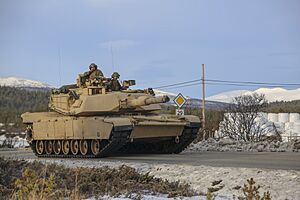
The M1 Abrams uses a secret British-developed composite armor. This "special armor" is thickest at the front of the hull and on the front and sides of the turret. It is much thicker than armor on older tanks. Chobham armor is very good at stopping shaped charges, which are special explosives designed to penetrate armor.
The exact makeup of the armor is secret. However, it is known to include ceramic blocks set in resin between layers of regular armor. These ceramic plates shatter on impact, breaking up incoming projectiles.
Later versions of the Abrams, starting with the M1A1 in 1988, added depleted uranium to the armor. This material is very dense and makes the tank even more protected against kinetic energy rounds. All M1A1 and M1A2 tanks in active service have been upgraded with this type of armor. Each new version of the Abrams has improved depleted uranium armor.
The M1A2 SEPv3, for example, has very strong frontal armor. It can also be fitted with explosive reactive armor (ERA) on the sides and slat armor on the rear. These provide extra protection against rockets and missiles.
Damage Control and Crew Safety
The Abrams has a special fire suppression system that automatically puts out fires in the crew compartment. Fuel and ammunition are stored in armored areas with "blowout panels." If the tank is hit and the ammunition explodes, these panels direct the blast away from the crew, keeping them safe. The main gun's ammunition is stored behind blast doors that only open when a round is needed for firing.
NBC Protection
Starting with the M1A1, the Abrams has a system that protects the crew from nuclear, biological, and chemical (NBC) attacks. This system creates a slight overpressure inside the tank, preventing harmful agents from entering. Crews still carry NBC masks as a backup.
Active Protection Systems
Some Abrams tanks are equipped with active protection systems (APS). These systems can either confuse incoming missiles or fire small rounds to deflect them. In 2016, the U.S. Army and Marine Corps began testing the Israeli Trophy APS. This system can protect Abrams tanks from modern rockets and anti-tank missiles. By January 2021, enough Trophy systems were delivered to equip four tank brigades.
Armament of the Abrams
Main Gun
105 mm Rifled Gun
The first M1 Abrams tanks used a 105 mm rifled gun called the M68A1. This gun could fire different types of rounds, including armor-piercing and high-explosive rounds. The tank could carry 55 of these rounds.
120 mm Smoothbore Gun
The M1A1 and M1A2 versions of the Abrams use a more powerful 120 mm smoothbore gun called the M256. This gun is made in the U.S. under license from Germany. Because of its larger size, the tank can carry 40 or 42 rounds for this gun.
- Elevation: −9 to +20 degrees
The M256 fires ammunition with cases that burn up when fired. The main armor-piercing round is the M829 series, which uses depleted uranium. Different versions of the M829 have been developed to defeat newer types of enemy armor.
The Abrams also fires high-explosive anti-tank (HEAT) rounds, like the M830. A newer version, the M830A1, can be used against armored vehicles, people, and even low-flying aircraft.
A special anti-personnel round called the M1028 was introduced for use in the Iraq War. It fires over a thousand small tungsten balls, like a giant shotgun, effective up to 600 meters. There is also an M908 round designed to destroy obstacles.
The U.S. Army is developing a new round called the M1147 (AMP) round. This single round will combine the abilities of several older rounds, simplifying logistics. It will have different modes, including point detonation, delay, and airburst, and can be programmed by the crew.
Secondary Weapons
The Abrams tank has three machine guns:
- A .50 caliber (12.7 mm) M2HB machine gun in front of the commander's hatch. On M1 and M1A1 tanks, the commander can aim and fire this gun from inside the tank. On M1A2 tanks, a remote-controlled weapon station (CROWS) can be added, allowing the commander to fire without exposing themselves.
- A 7.62 mm M240 machine gun in front of the loader's hatch. This gun can be fitted with shields and night-vision scopes.
- A second 7.62 mm M240 machine gun mounted next to the main gun. This "coaxial" gun aims at the same target as the main gun and is fired using the same computer system.
Aiming System
The Abrams has a very advanced computer system to help aim its main gun. This system uses data from many sources, like a laser rangefinder to measure distance, a sensor for wind speed, and information about the ammunition. It calculates the best way to aim the gun 30 times per second. The gunner just needs to keep a special aiming mark on the target and fire.
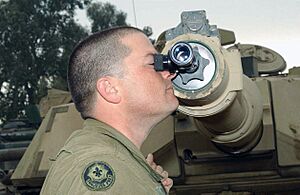
Both the commander and the gunner can fire the main gun. The M1A2 has a special thermal viewer for the commander. This allows the commander to find new targets while the gunner is busy with another. If the main aiming system breaks, the crew can still aim the guns manually using a backup telescopic sight.
Recent upgrades have given the Abrams better and longer-range sights. These improvements help the commander and gunner work together more quickly to find and hit targets.
Mobility and Movement
How the Abrams Moves
The M1 Abrams is powered by a special gas turbine engine. This engine produces 1,500 horsepower and can use different types of fuel, including diesel and jet fuel. It allows the tank to reach a top speed of 45 mph (72 km/h) on roads and 30 mph (48 km/h) off-road.
The turbine engine is very quiet compared to diesel engines, which earned the Abrams the nickname "whispering death." However, it uses a lot of fuel, which can be a challenge for logistics.
Some Abrams tanks have an external auxiliary power unit (APU). This allows the tank to run some systems without turning on the main engine, saving fuel and reducing noise. Later versions have an APU located inside the tank.
The Abrams is not designed to carry many soldiers, but a squad of infantry can ride on the rear of the tank during certain operations.
Transporting the Abrams
Moving the Abrams tank over long distances can be challenging because it is so heavy. It can be carried by large military transport planes like the C-5 Galaxy or the C-17 Globemaster III. However, these planes can only carry one or two tanks at a time. For large deployments, tanks are usually transported by ship.
The Abrams can also be transported by special trucks called Heavy Equipment Transporter Systems (HETS). These trucks can carry the tank on highways and off-road.
Tank Platoon Operations
U.S. Army and Marine Corps
In the U.S. Army and Marine Corps, a tank platoon usually has four Abrams tanks. These are organized into two sections, with two tanks in each section. The platoon leader commands the first tank, and the platoon sergeant commands the fourth tank.
This setup allows the tanks to work together closely. The platoon leader guides the group, and the other tanks follow their lead. Tank platoons are part of larger armored companies, which can be combined with infantry units for different missions.
Maintenance and Operation
The M1 Abrams tanks require detailed maintenance. There are many technical manuals that cover how to maintain and operate different parts of the tank. These manuals explain everything from the engine to the tracks.
- Hull Components
- Engine and Powertrain: This includes the type of engine, its parts, and how to maintain them. It also covers the transmission, which helps the tank change gears.
- Mobility Systems: This section details the suspension, which helps the tank move smoothly over rough ground. It also covers the tracks, which are like the tank's feet, and how to replace them. The steering and braking systems are also explained.
Ukraine Tank Organization
A Ukrainian tank battalion has 31 tanks. It is made up of three companies, each with three platoons. Each platoon has three tanks. There are also extra command tanks for the company and battalion leaders.
Abrams Tank Versions and Upgrades
- M1: This was the first version produced from 1979 to 1985. It had the 105 mm gun. The U.S. Army retired this version in 1996.
- IPM1: An improved M1 produced from 1984 to 1986. It had better armor and other small upgrades.
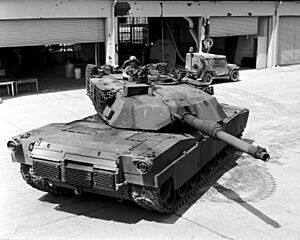
- M1A1: Produced from 1985 to 1993. It featured the more powerful 120 mm gun, improved armor, and a CBRN protection system.
- M1A1HA (Heavy Armor): This version added the first generation of depleted uranium armor.
- M1A1HC (Heavy Common): Had new, second-generation depleted uranium armor and other small upgrades.
- M1A1 AIM (Abrams Integrated Management): Older M1A1s were rebuilt to factory standards and improved with thermal sights and better communication systems. Australia bought 59 of these.
- M1A1 SA (Situational Awareness): Similar to AIM, with new third-generation depleted uranium armor. This version was supplied to Morocco and Ukraine.
- M1A1 FEP (Firepower Enhancement Package): An upgrade for U.S. Marine Corps tanks.
- M1A1M: An export version for the Iraqi Army.
- M1A2: This version was produced from 1991. It gave the tank commander an independent thermal sight and improved armor.
- M1A2 SEP (System Enhancement Package): Had new, second-generation thermal sights and third-generation depleted uranium armor.
- M1A2S: An upgrade for Saudi Arabian M1A2s.
- M1A2 SEPv2: Added a remote-controlled weapon station, color displays, and better cooling.
- M1A2 SEPv3 (formerly M1A2C): Has increased power, better communication, improved armor against roadside bombs, and an Auxiliary Power Unit (APU) under armor. It also uses new types of ammunition and improved thermal imaging. The U.S. Army aims to make this the standard tank.
- M1A2T: A special version of the M1A2 SEPv3 for Taiwan, with export armor instead of depleted uranium.
- M1A2R: A version of the M1A2 SEPv3 being developed for the Romanian Army.
- M1A2K: A variant for the Kuwaiti Army.
- M1E3: The U.S. Army announced this new variant in September 2023. It will have a modular design, be lighter, and more survivable. It is expected to be called M1A3 when it enters service in the 2030s.
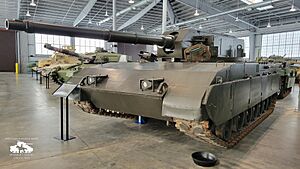
- M1 TTB (Tank Test Bed): A prototype from 1983 with an unmanned turret and a crew of three in the hull. It was designed to test new ideas for future tanks.
- M1 Thumper: A prototype that tested a more powerful 120 mm gun or a 140 mm gun.
- CATTB (Component Advanced Technology Test Bed): Two prototypes from the 1990s that tested many new technologies, including a 140 mm gun, a new engine, and advanced suspension.
- AbramsX: A technology demonstration tank from General Dynamics Land Systems. It is lighter, has a new gun with an autoloader, a hybrid engine for better fuel efficiency, and advanced protection systems. It can also use drones.
Specialized Abrams Vehicles
- M1 Panther II: A tank designed to clear mines. It has its turret removed and uses mine rollers on the front.
- M104 Wolverine Heavy Assault Bridge: An Abrams tank modified to carry and deploy a 26-meter long bridge, helping troops cross gaps.
- M1 Grizzly (Breacher): Designed to clear minefields and obstacles using a dozer blade and a robotic arm.
- M1074 Joint Assault Bridge (JAB): A newer bridgelayer that combines a heavy "scissor" bridge with the Abrams chassis.
- M1150 Assault Breacher Vehicle (ABV): An assault vehicle for the U.S. Marine Corps. It has a mine plow, linear demolition charges, and reactive armor for protection.
Additional Equipment
Abrams tanks can be fitted with various tools for specific missions:
- Mine clearing plows and rollers: These attachments help clear mines from a path.
- Surface Clearance Device (SCD): Used to clear mines and bombs from roads and trails.
- Vehicle Magnetic Signature Duplicator (VEMSID): This device helps detonate magnetic mines safely.
- Bulldozer attachment: An attachment for pushing dirt and obstacles, though it was not widely used due to overheating issues.
Abrams Specifications
| M1 | IPM1 | M1A1 | M1A2 | M1A2 SEP | |
|---|---|---|---|---|---|
| Produced | 1979–85 | 1984–1986 | 1985–92 | 1992 on | 1999 on |
| Length (gun forward) | 32 ft 0.5 in (9.77 m) | 32 ft 2.9 in (9.83 m) | |||
| Width (over skirt) | 12 ft (3.7 m) | ||||
| Height (over 0.50 in (12.7 mm) machine gun) |
9 ft 5.6 in (2.885 m) | n/a | |||
| Top speed (level road) | 45 mph (72 km/h) | 41.5 mph (66.8 km/h) | 42 mph (68 km/h) | ||
| Range | 275 mi (443 km) | 289 mi (465 km) | 265 mi (426 km) | 264 mi (425 km) | |
| Power | 1,500 shp (1.1 MW) at 3000 rpm | ||||
| Combat Weight | 58 short tons (53 t) | 60 short tons (54 t) | M1A1: 63 short tons (57 t) M1A1SA: 67.6 short tons (61.3 t) |
69.5 short tons (63.0 t) | SEP v1: 69.5 short tons (63.0 t) SEP v2: 71.2 short tons (64.6 t)SEP v3: 73.6 short tons (66.8 t) |
| Main armament | 105 mm M68A1 rifled | 120 mm M256 smoothbore | |||
| Crew | 4 (commander, gunner, loader, driver) | ||||
Who Uses the Abrams Tank?
Current Operators
 Australia – Australian Army: Has 59 M1A1 tanks. Australia is buying 75 new M1A2 SEPv3 tanks, which will start arriving in 2024. In October 2024, Australia announced it would give 49 of its retired M1A1 tanks to Ukraine.
Australia – Australian Army: Has 59 M1A1 tanks. Australia is buying 75 new M1A2 SEPv3 tanks, which will start arriving in 2024. In October 2024, Australia announced it would give 49 of its retired M1A1 tanks to Ukraine. Egypt – Egyptian Army: Has 1,130 M1A1 tanks. These tanks were assembled in Egypt with help from the U.S.
Egypt – Egyptian Army: Has 1,130 M1A1 tanks. These tanks were assembled in Egypt with help from the U.S.
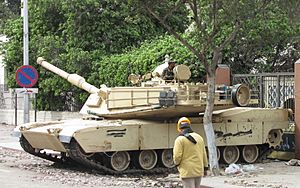
 Iraq – Iraqi Army: Has 100 M1A1 tanks. Iraq bought 120 M1A1SA tanks from the U.S. between 2010 and 2011.
Iraq – Iraqi Army: Has 100 M1A1 tanks. Iraq bought 120 M1A1SA tanks from the U.S. between 2010 and 2011. Kuwait – Kuwaiti Army: Has 218 M1A2K tanks. Kuwait received the first of its new M1A2K tanks in 2021.
Kuwait – Kuwaiti Army: Has 218 M1A2K tanks. Kuwait received the first of its new M1A2K tanks in 2021. Morocco – Royal Moroccan Army: Has 222 M1A1SA tanks. Deliveries began in 2016. Morocco is also upgrading 162 tanks to the M1A2 SEPv3 version.
Morocco – Royal Moroccan Army: Has 222 M1A1SA tanks. Deliveries began in 2016. Morocco is also upgrading 162 tanks to the M1A2 SEPv3 version.
 Poland – Polish Land Forces: Poland bought 116 former U.S. Marine Corps M1A1 tanks, with deliveries completed in June 2024. Poland also bought 250 M1A2 SEPv3 tanks, which are expected to be delivered in early 2025.
Poland – Polish Land Forces: Poland bought 116 former U.S. Marine Corps M1A1 tanks, with deliveries completed in June 2024. Poland also bought 250 M1A2 SEPv3 tanks, which are expected to be delivered in early 2025. Saudi Arabia – Saudi Arabian Army: Has 575 M1A2S tanks. Many of their M1A2s have been upgraded to the M1A2S version.
Saudi Arabia – Saudi Arabian Army: Has 575 M1A2S tanks. Many of their M1A2s have been upgraded to the M1A2S version. South Korea – Republic of Korea Army & Marine Corps: Uses the K1 series, which is a version of the M1 Abrams customized for South Korea.
South Korea – Republic of Korea Army & Marine Corps: Uses the K1 series, which is a version of the M1 Abrams customized for South Korea. Taiwan – Republic of China Army: Taiwan is buying 108 M1A2T tanks from the U.S. The first two were delivered in June 2022, and more arrived in December 2024.
Taiwan – Republic of China Army: Taiwan is buying 108 M1A2T tanks from the U.S. The first two were delivered in June 2022, and more arrived in December 2024.
 Ukraine – Ukrainian Ground Forces: Has 31 M1A1SA tanks. These were delivered by October 2023 as part of U.S. support. As of July 1, 2025, 22 of these tanks have been visually confirmed as lost. Australia also announced in October 2024 that it would transfer 49 M1A1 tanks to Ukraine.
Ukraine – Ukrainian Ground Forces: Has 31 M1A1SA tanks. These were delivered by October 2023 as part of U.S. support. As of July 1, 2025, 22 of these tanks have been visually confirmed as lost. Australia also announced in October 2024 that it would transfer 49 M1A1 tanks to Ukraine. United States – United States Army: Has over 8,100 M1, M1A1, and M1A2 tanks combined. As of January 2025, the U.S. Army has 2,640 tanks in service, with more in storage.
United States – United States Army: Has over 8,100 M1, M1A1, and M1A2 tanks combined. As of January 2025, the U.S. Army has 2,640 tanks in service, with more in storage.
Future Operators
 Bahrain – Royal Bahraini Army: In March 2024, the U.S. approved the possible sale of 50 M1A2 SEPv3 Abrams tanks to Bahrain.
Bahrain – Royal Bahraini Army: In March 2024, the U.S. approved the possible sale of 50 M1A2 SEPv3 Abrams tanks to Bahrain. Romania – Romanian Land Forces: In May 2023, Romania approved buying 54 used M1A2 Abrams tanks from U.S. Army stocks. These will be upgraded to the M1A2R version.
Romania – Romanian Land Forces: In May 2023, Romania approved buying 54 used M1A2 Abrams tanks from U.S. Army stocks. These will be upgraded to the M1A2R version.
Former Operators
 United States – United States Marine Corps: The Marine Corps transferred all its M1 Abrams tanks to the U.S. Army by May 2021 as part of a plan to focus on amphibious warfare.
United States – United States Marine Corps: The Marine Corps transferred all its M1 Abrams tanks to the U.S. Army by May 2021 as part of a plan to focus on amphibious warfare.
See also
 In Spanish: M1 Abrams para niños
In Spanish: M1 Abrams para niños






